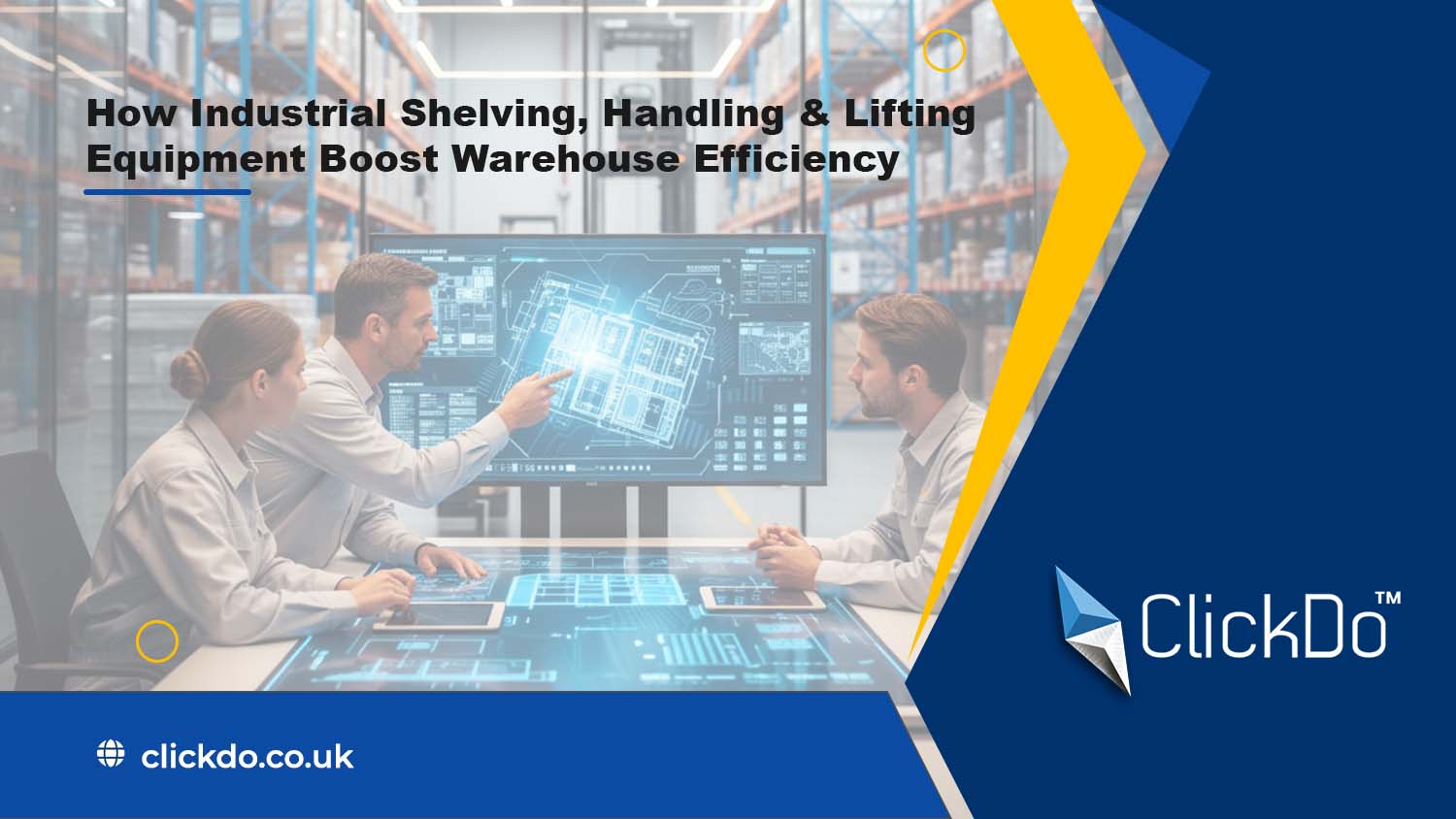
How Industrial Shelving, Handling & Lifting Equipment Boost Warehouse Efficiency
Table of Contents
UK logistics and warehouse sectors face relentless pressure to move goods faster, store more, and operate with greater precision. As demand grows, the physical limits of a warehouse become a critical barrier to growth.
The key to unlocking potential lies not in simply acquiring more space, but in optimising what you already have. The right combination of industrial shelving and handling and lifting equipment forms the backbone of any productive, safe, and efficient warehouse operation.
This guide explores how these two essential systems work together. We will cover how to select the right components, integrate them for seamless workflow, and avoid common pitfalls.
For any UK business aiming for operational excellence, understanding this synergy is non-negotiable.
What is Industrial Shelving?

Industrial shelving is a broad term for heavy-duty storage systems designed to hold bulk materials, palletised goods, and individual items in a commercial or industrial environment. Unlike standard shelving, it is engineered for high load capacities, durability, and safety. Choosing the right system is fundamental to maximising storage density and ensuring easy access to inventory.
Key types of industrial shelving include:
- Pallet Racking: The most common system, designed to store materials on pallets. It consists of upright frames and horizontal beams, allowing forklifts to access goods directly.
- Boltless Shelving: A versatile and easy-to-assemble option ideal for storing smaller boxes, parts, and non-palletised items. Its adjustability makes it perfect for changing inventory needs.
- Cantilever Racking: This system is designed for long, bulky, or awkwardly shaped items like timber, pipes, or furniture. It features arms extending from a central column, providing unobstructed horizontal storage.
- Mezzanine Flooring: A cost-effective way to double your floor space. Mezzanines are elevated platforms that create an additional level for storage, office space, or assembly work within an existing high-ceilinged warehouse.
When selecting a shelving system, consider its load capacity, adjustability, and compliance with British and European safety standards. The right choice directly impacts how efficiently you can store and retrieve goods, defining the flow of your entire operation.
What is Handling & Lifting Equipment?
Handling and lifting equipment refers to any machinery used to move goods safely and efficiently within the warehouse. Its purpose is to reduce manual labour, prevent injuries, and speed up the movement of inventory from receiving to dispatch.
Common examples include:
- Forklifts and Pallet Trucks: Essential for moving palletised goods to and from pallet racking.
- Hoists and Cranes: Used for lifting extremely heavy or bulky items, often in conjunction with mezzanine floors or high-bay racking.
- Conveyors: Automated systems that transport goods along a fixed path, ideal for moving high volumes of items between different zones, such as from picking areas to packing stations.
In the UK, all such equipment must comply with strict safety regulations, including the Provision and Use of Work Equipment Regulations (PUWER) and the Lifting Operations and Lifting Equipment Regulations (LOLER). This means employers are legally required to ensure equipment is fit for purpose, properly maintained, and operated only by trained and competent staff.
How They Work Together for Peak Efficiency

The true power of warehouse optimisation comes from the seamless integration of industrial shelving with handling and lifting equipment. When these systems are planned in harmony, they create a highly efficient workflow that boosts productivity and enhances safety.
Consider these practical examples:
- Pallet Racking and Forklifts: The aisle width between pallet racking must be precisely calculated to match the turning radius of your forklifts. Too narrow, and you risk collisions and damage. Too wide, and you waste valuable floor space. The racking height must also correspond with the forklift’s maximum lift height.
- Mezzanine Floors and Conveyors: A mezzanine floor is only as useful as your ability to get goods onto and off it. Installing a goods lift, or an incline conveyor system, creates an efficient flow, allowing staff to move stock between levels without manual effort or bottlenecks.
An integrated approach reduces travel distances for staff and machinery, prevents congestion in busy areas, and minimises the risk of accidents. It transforms a collection of separate components into a single, cohesive operational system.
Common Challenges & Pitfalls
Even with the best intentions, many warehouses fail to achieve optimal efficiency due to common planning and operational mistakes.
- Overloading Shelving: Exceeding the stated load capacity of shelving is a primary cause of structural failure, leading to catastrophic collapses, inventory loss, and serious risk to life.
- Inefficient Layouts: Designing a storage layout without considering handling routes creates bottlenecks. If forklifts have to take long, convoluted paths to reach goods, you lose valuable time and increase fuel or energy consumption.
- Equipment Neglect: Failing to perform regular maintenance on shelving and lifting equipment leads to wear and tear, unexpected breakdowns, and significant safety hazards. A damaged rack or a faulty hoist can bring operations to a standstill.
- Poor Scalability Planning: A system that works for you today may not work tomorrow. Choosing equipment that cannot be easily expanded or reconfigured restricts your ability to adapt to business growth or changing market demands.
Best Practice Tips for Success

To avoid these pitfalls and build a truly efficient warehouse, follow these best practice tips:
- Conduct Regular Inspections: Implement a schedule for regular visual inspections and professional load testing of all shelving systems to ensure they remain safe and compliant.
- Design Around Your Workflow: Before installing any equipment, map out your entire operational process from goods-in to goods-out. Design the layout to support this natural flow, not hinder it.
- Invest in Staff Training: Ensure all operators are fully trained and certified in the safe use of handling and lifting equipment. A well-trained team is a safe and productive team.
- Partner with Reputable Suppliers: Choose suppliers who not only provide high-quality equipment but also offer expert advice, installation services, and after-sales support, including maintenance plans.
- Consider Phased Upgrades: A complete overhaul can be disruptive. Plan for phased upgrades that allow you to improve your systems gradually without significant downtime.
Future Trends & Innovations
The evolution of warehouse technology continues at a rapid pace. UK businesses should keep an eye on emerging trends to future-proof their operations:
- Automated Guided Vehicles (AGVs): These robotic vehicles can transport goods autonomously, following pre-defined paths to work alongside or replace traditional forklifts.
- Smart Shelving: Racking systems integrated with sensors can monitor inventory levels, track item locations, and even detect if a shelf is overloaded, sending alerts to management.
- IoT-Enabled Equipment: Handling and lifting equipment connected to the Internet of Things (IoT) can self-diagnose maintenance needs and automatically report performance data, preventing breakdowns before they happen.
- Sustainable & Modular Design: A growing focus on sustainability is driving demand for shelving made from recycled materials and modular systems that can be reconfigured and reused, reducing waste.
Closing Thoughts
The efficiency, safety, and profitability of your warehouse depend directly on the strategic alignment of your industrial shelving and handling and lifting equipment. By treating them as a single, integrated system, UK businesses can unlock hidden potential, improve productivity, and build a scalable foundation for future growth. A well-planned warehouse is more than just a storage space; it is a powerful competitive advantage.
Author Profile
- Online Media & PR Strategist
- Blogger and Educator by Passion | Contributor to many Business Blogs in the United Kingdom | Fascinated to Write Blogs in News & Education I have completed a journalism summer course at the London School of Journalism and manage various blogs.
Latest entries
 BusinessOctober 8, 2025How Industrial Shelving, Handling & Lifting Equipment Boost Warehouse Efficiency
BusinessOctober 8, 2025How Industrial Shelving, Handling & Lifting Equipment Boost Warehouse Efficiency BusinessSeptember 10, 20255 Customer Service Must-Do’s That Boost Customer Loyalty
BusinessSeptember 10, 20255 Customer Service Must-Do’s That Boost Customer Loyalty HRAugust 18, 2025From Developer Pools to Product Teams: The Quiet Shift in Software Outsourcing
HRAugust 18, 2025From Developer Pools to Product Teams: The Quiet Shift in Software Outsourcing BusinessAugust 12, 2025How Do Business Loans in Property Development Work in the UK?
BusinessAugust 12, 2025How Do Business Loans in Property Development Work in the UK?

